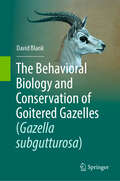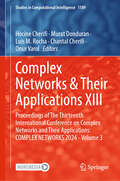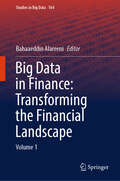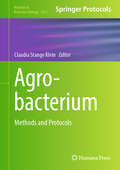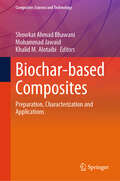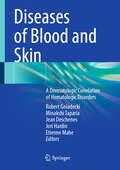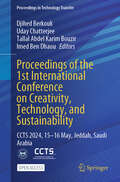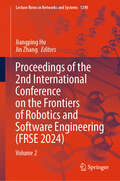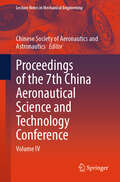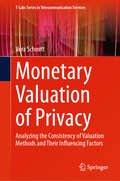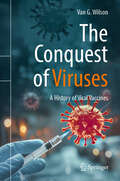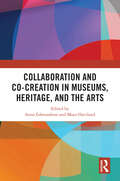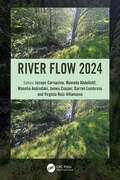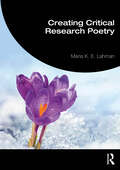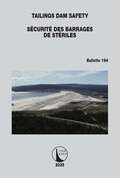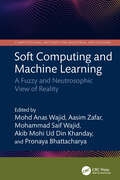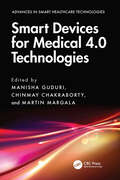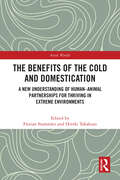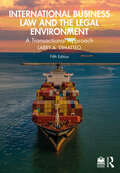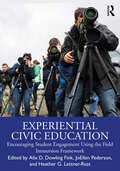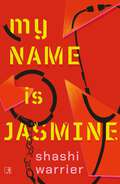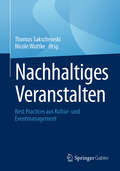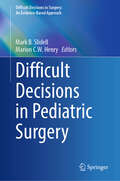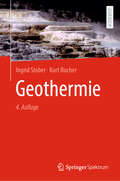- Table View
- List View
The Behavioral Biology and Conservation of Goitered Gazelles (Gazella subgutturosa)
by David BlankThis comprehensive and lavishly illustrated book summarizes all known information on the Goitered Gazelle (Gazella subgutturosa), one of the world's most endangered antelopes. It includes information on topics such as feeding ecology, behavior, vocalizations, parasites and diseases, and conservation. This research monograph will be of interest to professional researchers of ungulates, university staff, students, and naturalists.
Complex Networks & Their Applications XIII: Proceedings of The Thirteenth International Conference on Complex Networks and Their Applications: COMPLEX NETWORKS 2024 - Volume 3 (Studies in Computational Intelligence #1189)
by Hocine Cherifi Murat Donduran Luis M. Rocha Chantal Cherifi Onur VarolThis book highlights cutting-edge research in network science, offering scientists, researchers, students, and practitioners a unique update on the latest advances in theory and a multitude of applications. It presents the peer-reviewed proceedings of the XIII International Conference on Complex Networks and their Applications (COMPLEX NETWORKS 2024). The carefully selected papers cover a wide range of theoretical topics such as network embedding and network geometry; community structure, network dynamics; diffusion, epidemics, and spreading processes; machine learning and graph neural networks, as well as all the main network applications, including social and political networks; networks in finance and economics; biological networks and technological networks.
Big Data in Finance: Volume 1 (Studies in Big Data #164)
by Bahaaeddin AlareeniThis book offers a comprehensive exploration of how Big Data analytics is reshaping the financial world, providing crucial insights for industry professionals, scholars, and enthusiasts alike. This book delves into the expansive potential of Big Data in revolutionizing financial decision-making, risk management, and operational efficiency. It explores how advanced analytics, machine learning, and artificial intelligence are disrupting traditional financial models, empowering institutions with unparalleled insights and a competitive edge. While highlighting technological advancements, the book also addresses the challenges and ethical considerations inherent in data-driven finance. With contributions from leading experts and thought leaders, this book serves as an indispensable resource for anyone eager to understand and harness the transformative power of Big Data in finance. Embark on a journey through the dynamic convergence of finance and technology, and discover how Big Data is shaping the future of the financial landscape, one data point at a time.
Agrobacterium: Methods and Protocols (Methods in Molecular Biology #2911)
by Claudia Stange KleinThis volume details Agrobacterium strain methods, such as plant genotype, transient and stable transformation of plants for gene overexpression, silencing, transplastomic and editing. Transformation protocols are focused mainly in plants with economic importance such as cereals and fruit trees including diploids and polyploids, and in non-plant species such fungi and algae. Written in the highly successful Methods in Molecular Biology series format, chapters include introductions to their respective topics, lists of the necessary materials and reagents, step-by-step, readily reproducible laboratory protocols, and key tips on troubleshooting and avoiding known pitfalls. Authoritative and cutting-edge, Agrobacterium: Methods and Protocols aims to be a useful and practical guide to new researchers and experts looking to expand their knowledge.
Biochar-based Composites: Preparation, Characterization and Applications (Composites Science and Technology)
by Showkat Ahmad Bhawani Mohammad Jawaid Khalid M. AlotaibiThis book provides solid, quantitative descriptions and reliable guidelines, reflecting the maturation and demand of the field and the development of biochar-based composites. This book summarizes the fundamental approaches and principles to prepare biochar-based composites. This book focuses on some important materials (metal oxide/hydroxide, magnetic, clay minerals, graphene oxide, etc.) used for the production of the composites. The coverage of book highlights the most exciting applications of biochar-based composites in the removal of organic and inorganic contaminants from waste water. The book is useful for the academics and researchers who are interested in the development biochar-based composites with background in material science, chemical engineering, environmental engineering and environmental chemistry.
Diseases of Blood and Skin: A Dermatologic Correlation of Hematologic Disorders
by Robert Gniadecki Minakshi Taparia Jean Deschenes Jori Hardin Etienne MaheDiseases of the hematopoietic system often manifest themselves in the skin, and some manifestations are so typical that the dermatologist may be the first physician to detect the underlying blood disorder. More commonly, however, skin symptoms arise in the context of a known hematopoietic disease. This book reviews skin signs and symptoms that develop secondarily to underlying malignant or benign diseases of the hematopoietic system, and mainly built as a clinical text to support the physician in making a correct diagnosis and understanding the significance of skin signs for the prognosis and management of the hematological disease. The malignant hematological diseases comprise approximately 80% of the book, which reflects the spectrum of patients in hematology departments, as well as the experience of the authors. In addition to its pragmatic structure that enables the reader to find relevant information, tables are included for differential diagnoses and cross-referencing the skin sign with hematological diagnoses and vice versa. For each chapter, ample background information is provided to convey dermatologists the essence of hematological disorders. Likewise, to enhance understanding among hematologists, dermatological jargon is avoided and skin signs described in understandable terms, underscoring the patterns of the lesions and key features allowing the non-dermatologist clinician to differentiate one skin condition from another.This book is primarily for the physicians who see adult patients; to achieve consistency and readability, the work is meant as a monograph written by specialists in the field, who collaborate with one another on a daily basis. While not aiming to be an exhaustive reference work, it is built as an intelligible handbook that for the first time covers the cross-section of dermatology and hematology. The audience comprises dermatologists working in an academic or hospital setting, as well as hematologists and internists who manage patients with blood diseases in their daily clinical practice.
Proceedings of the 1st International Conference on Creativity, Technology, and Sustainability: CCTS 2024, 15–16 May, Jeddah, Saudi Arabia (Proceedings in Technology Transfer)
by Djihed Berkouk Uday Chatterjee Tallal Abdel Karim Bouzir Imed Ben DhaouThis open-access book presents peer-reviewed articles from the 1st International Conference on Creativity, Technology, and Sustainability (CCTS), held on May 15–16, 2024, at Dar Al-Hekma University in Jeddah, Saudi Arabia. It explores the dynamic interplay between technology and sustainability, emphasizing the need for advancements to align with Saudi Arabia's Vision 2030 and the United Nations Sustainable Development Goals (SDGs). The book includes case studies, literature reviews, and scientific works, organized into five main parts: Technology for Innovation and Safety, Sustainable Solutions for Technology and Infrastructure, Transforming Education and Social Impact, Sustainable Environment and Smart Cities, and Technologies for Health, Environment, and Sustainability. Readers will discover how technology fosters innovation, safety, and sustainability across various fields, aligning with specific UN SDGs. Practical applications highlight sustainability awareness and responsible behavior, facilitating knowledge transfer for the public sector, innovative companies, academia, and research centers. Targeting researchers, policymakers, sustainability advocates, and decision-makers committed to achieving the UN's SDGs and Saudi Vision 2030, this book identifies key areas for attention in architecture, design, social and environmental sciences, law, and business. It serves as a valuable guide for professionals in technology-driven sectors like Artificial Intelligence and the Internet of Things, emphasizing technology's vital role in addressing sustainability challenges, enhancing efficiency, promoting environmentally friendly processes, and reducing costs, ultimately improving the quality of life for all.
Proceedings of the 2nd International Conference on the Frontiers of Robotics and Software Engineering: Volume 2 (Lecture Notes in Networks and Systems #1290)
by Jiangping Hu Jin ZhangThe proceeding of FRSE presents a collection of innovation research in the cutting edge fields of robotics and software engineering. It is highlighted within that there are novel methodologies, critical analyses, and breakthrough results which emphasize the enhanced or amplified results achieved when robotics technologies are integrated with advanced software. This book is outfitted with numerous diagrams, tables, and conceptual frameworks, structured to enhance comprehension and accessibility, that facilitate a deeper understanding of complex topics. The presentation is not just theoretical but includes case studies and real-world applications, offering a practical approach to complex problem-solving techniques across related industries. Readers will receive benefits from this comprehensive resource, gain a renew understanding of contemporary challenges and innovative solutions in robotics and software engineering. And this book will be a guide and asset for research scholars and professionals in robotics and software engineering looking to apply these these cutting-edge technologies in impactful ways.
Proceedings of the 7th China Aeronautical Science and Technology Conference: Volume IV (Lecture Notes in Mechanical Engineering)
by Chinese Society of Aeronautics and AstronauticsThis book contains the selected papers from the 7th China Aeronautical Science and Technology Conference. Topics include, but are not limited to: key technologies for aircraft (including fixed-wing, rotorcraft, new concept aircraft, etc.) design and overall optimization; aerodynamics; flight mechanics; structural design; advanced aviation materials (including composite materials); advanced aviation manufacturing; and design and overall optimisation; aerodynamics and flight mechanics; structural design; advanced aeronautical materials (including composite materials); advanced aeronautical manufacturing technology; advanced aeronautical propulsion technology; navigation, guidance and control technology; airborne systems, electromechanical technology; environmental control, life-saving technology; key technologies for multi-electric aircraft and all-electric aircraft; aviation testing technology; critical technologies in the vicinity of space vehicles; unmanned aerial vehicles and related technologies; general aviation flight safety, civil aviation transportation and air quality; aviation science and technology and industrial development policy and planning; other related technologies. Make this book a valuable resource for researchers, engineers and students.
Monetary Valuation of Privacy: Analyzing the Consistency of Valuation Methods and Their Influencing Factors (T-Labs Series in Telecommunication Services)
by Vera SchmittThis book explores the complex domain of personal data valuation, uncovering how individuals perceive the worth of their privacy in an era dominated by digital information exchange. The book delves into the largely scattered empirical research domain of how users value their own data, analyzing how companies like Google and Facebook rely heavily on the continuous collection of personal data to run their business models. By examining concepts like ‘Willingness to Pay’ and ‘Willingness to Accept’ in the context of privacy, the book offers a comprehensive overview of how people navigate the often-ambiguous trade-offs between sharing personal information and safeguarding their privacy. Through an empirical analysis supported by 14 crowdsourcing and two field experiments, the author investigates the influence of various factors—such as Privacy Concerns, Privacy Behavior, and Privacy Literacy—on the monetary assessment of privacy. The book also contrasts different methodological approaches to determine which yields the most reliable results, shedding light on the behavioral biases that can skew data valuation. This book is ideal for anyone interested in the intersection of privacy, economics, and digital ethics. The author not only offers insights into the current landscape but also proposes robust models for understanding and predicting how people value their privacy in different contexts. Whether you are a researcher, policymaker, or simply a concerned digital citizen, this book provides valuable perspectives on the monetization of personal data and the future of privacy in the digital age.
The Conquest of Viruses: A History of Viral Vaccines
by Van G. WilsonThis book guides through the fascinating history of viral vaccines, from the first primitive smallpox vaccination in the 18th century to the cutting-edge RSV formulation approved in 2023. Each chapter delves into the scientific, clinical, and social forces that led to the development of these life-saving medical innovations, highlighting the scientists who played pivotal roles. With a focus on making complex science accessible and history engaging, this book offers a comprehensive portrayal of virology, vaccinology and the interplay between science and society in shaping public health. Readers will explore key concepts such as the evolution of vaccine technology over time, from cowpox material to mRNA vaccines, and a wide array of other topics, including the eradication of diseases through vaccines, the challenges of immunization against influenza, and the revolutionary impact of COVID-19 vaccination. The author, microbiologist Professor Wilson, provides expert analysis on how sociological factors influenced vaccine progress and gets to the bottom of the question of why there is still no vaccine for some critical diseases. This book is a must-read for anyone with an interest in viruses and vaccines. Whether you're a researcher or simply fascinated by medical history, this book promises to be both informative and entertaining.
Environmental Regulation and the History of Capitalism: The Role of Business from Stockholm 1972 to the Climate Crisis (Routledge International Studies in Business History)
by Sandra Bott Sabine Pitteloud Janick Marina SchaufelbuehlThis edited collection examines the historical role of business actors in climate and environmental governance since the 1970s. Through a compilation of recent, evidence-based historical research, this book unveils the origins of contemporary challenges in regulating environmental pollution. With original case studies, it offers a nuanced understanding of the environmental counter-offensive orchestrated by business leaders, associations, and think tanks post-1972, following the United Nations' pivotal Stockholm Conference on the Human Environment. Readers are presented with insights into the historical maneuvers of business entities aimed at mitigating regulatory risks, co-creating expertise, and framing the environmental debate. From revealing the tactics employed by various business actors to exploring the emergence of market-driven environmentalism, this volume offers a comprehensive exploration of the intricate dynamics shaping environmental policy. By contextualizing specificities and complexities, it enriches contemporary narratives on business influence and power dynamics within global capitalism. This book primarily caters to scholars across diverse historical disciplines, including business history, international relations, environmental history, and the history of capitalism. Additionally, it holds relevance for social scientists studying contemporary issues, policymakers grappling with environmental challenges, and those seeking a deeper understanding of the historical dimensions of climate governance.The Open Access version of this book, available at http://www.taylorfrancis.com, has been made available under a Creative Commons Attribution-Non Commercial-No Derivatives (CC BY-NC-ND) 4.0 license.
Collaboration and Co-Creation in Museums, Heritage, and the Arts
by Anna Edmundson and Maya HavilandCollaboration and Co-Creation in Museums, Heritage, and the Arts examines collaborative practices in museums, heritage and the arts. It offers an interdisciplinary approach combining both practical and theoretical perspectives from leading scholars and practitioners to better understand and support co-creation and collaboration in the cultural sector.The volume is divided into five parts, offering contemporary perspectives on core topics and their interconnections. Themes include the politics of engagement, sharing and recentring authority, decolonising research and practice, facilitating partnerships, and structuring cocreation, and community empowerment. Through global case studies and theoretical analyses, contributors explore the challenges and opportunities of collaborative practices, exploring intersecting dynamics, motivations and constraints. The book examines various scales of co-creation, from interpersonal dynamics to community contexts and institutional transformations. The work contributes to ongoing discussions about the future of cultural institutions and the role of culture work in fostering perspectives and practices informed by diverse perspectives and generating multiple values. It emphasizes co-production as a crucial capability for the sector moving forward.Collaboration and Co-Creation in Museums, Heritage, and the Arts is essential for students, academics, communities and cultural practitioners interested in the complexities and rewards of collaborative work. It offers valuable insights into the theories and practices that shape collaborative projects across different cultural contexts and disciplines, making it an indispensable guide for anyone engaged in or studying the cultural sector.
River Flow 2024: Proceedings of the 12th International Conference on Fluvial Hydraulics, Liverpool, UK, 2nd- 6th September, 2024
by Iacopo CarnacinaRiver Flow 2024 features keynote lectures and contributed papers presented at the 12th International Conference on Fluvial Hydraulics, held from September 2nd to 6th, 2024, in Liverpool.River Flow 2024 provides an overview of the latest experimental, theoretical, and computational findings on fundamental river flow and transport processes, river morphology, and morphodynamics. It also addresses the impacts of hydraulic structures on flow regimes, river morphology, and ecology; sustainable river engineering practices, including stream restoration and re-naturalization; and the effects of climate change, including extreme flood events. Additionally, the conference covers topics such as sediment, pollutant, and microplastic dynamics in rivers; fluid mechanics, numerical modelling, and two-phase flow; monitoring techniques and artificial intelligence; and natural flood management, vegetation, wood, and river restoration.River Flow 2024 aims to present ongoing and the state-of-the-art in river research and engineering, targeting academics and practitioners in hydraulics, hydrology, and environmental engineering. Organized under the auspices of the Committee on Fluvial Hydraulics of the International Association for Hydro-Environment Engineering and Research (IAHR), the River Flow conference series has gained international recognition as one of the most reputable events in the fluvial hydraulics community, attracting a large and loyal audience of river researchers and engineers. Thanks to the Stephen E. Coleman Award for the best research paper from a young academic and for its mission focused towards promoting knowledge transfer and idea exchange, it has also become a point of reference for the early career researcher and younger academics, with the master classes at the centre of it. The 12th edition also featured the “Networking and Mentoring Event: Embracing Gender Equity and Diversity” to enable all the member of the community to maximise their opportunity withing the sector.
Creating Critical Research Poetry
by Maria K. LahmanCreating Critical Research Poetry critically engages with the ways in which researchers can poetically approach textual representations that narrate the unnarratable and contest the uncontested.This text provides a rich path for early research poets to engage with and bloom and established research poets to dig deeper and flourish.Connections to literary poetry and critical social science theories are detailed. First-person poetic accounts where poets describe early fruitful engagement with poetic forms are highlighted. Free verse, formed poetry, and dimensional poems (e.g. concrete poetry) are covered in depth, with guidance for developing a poetic sensibility and honing research poetry craft. Poetic experiences are integrated throughout the book, which may be engaged with individually, as a group, and in virtual or face-to-face courses.Each chapter provides reflexive questions for the reader to engage with in their own journal writings, a poem creation exercise, and further poetic resources. Set within critical theories, Creating Critical Research Poetry provides a context for early research poets, and thought-provoking possibilities for seasoned research poets. This is the perfect entry point to this burgeoning field of critical inquiry and qualitative research.
Tailings Dam Safety / Sécurité des Barrages de Stériles (ICOLD Bulletins Series)
by International Commission on Large Dams Commission Internationale Des Grands BarragesICOLD Bulletin 194, Tailings Dam Safety, aims to assist the international community to further develop and adopt safe practices for tailings dam planning, design, construction, operation, and closure with a focus on the technical aspects that are mentioned but not fully developed in other recent National and Industry Guidelines and Standards. Governance and human aspects have also been touched on with appropriate references where other guidance documents are considered more comprehensive.The Bulletin consolidates key information from these Guidelines and Standards together with information from various previous ICOLD Bulletins that address specific aspects of the topic to provide a comprehensive overview of “what makes a tailings dam safe.” Comprehensive references are provided to assist users to access more detailed information where relevant.In preparing this bulletin, ICOLD has strived to consolidate “leading international practice” for tailings dams, with a focus on technical guidance.Le sous-comité de la CIGB sur les stériles a préparé le présent bulletin pour aider la communauté internationale à améliorer les pratiques en matière de sécurité lors des phases de planification, de conception, de construction, d’exploitation et de fermeture des installations, en détaillant en particulier les aspects techniques qui ont été mentionnés, sans avoir été complètement développés, dans d’autres ouvrages directeurs et normatifs récemment publiés par des organismes gouvernementaux et industriels. Les aspects liés à la gouvernance et aux personnes ont également été abordés en offrant les références appropriées lorsque d’autres documents directeurs ont été jugés plus complets sur le sujet.Le présent bulletin rassemble les principaux renseignements issus de ces lignes directrices et de ces normes ainsi que l’information provenant des divers bulletins antérieurs de la CIGB qui traitent d’aspects spécifiques du sujet afin de parvenir à une description complète de « ce qui assure la sécurité d’un barrage de stériles ». Des articles approfondis sont par ailleurs cités en référence pour aider le lecteur à accéder, le cas échéant, à des renseignements plus détaillés.En préparant ce bulletin, la CIGB s’est efforcée de faire la synthèse des « meilleures pratiques internationales » mises en œuvre pour les barrages de stériles, et privilégiant les recommandations techniques.
Soft Computing and Machine Learning: A Fuzzy and Neutrosophic View of Reality (Computational Methods for Industrial Applications)
by Mohd Anas Wajid Aasim Zafar Mohammad Saif Wajid Akib Mohi Ud Din Khanday Pronaya BhattacharyaThis reference text covers the theory and applications of soft computing and machine learning and presents readers with the intelligent fuzzy and neutrosophic rules that require situations where classical modeling approaches cannot be utilized, such as when there is incomplete, unclear, or imprecise information at hand or inadequate data. It further illustrates topics such as image processing, and power system analysis.This book: Discusses soft computing techniques including fuzzy Logic, rough sets, neutrosophic sets, neural networks, generative adversarial networks, and evolutionary computation Examines novel and contemporary advances in the fields of soft computing, fuzzy computing, neutrosophic computing, and machine learning systems, as well as their applications in real life Serves as a comprehensive reference for applying machine learning and neutrosophic sets in real-world applications such as smart cities, healthcare, and the Internet of Things Covers topics such as image processing, bioinformatics, natural language processing, supply chain management, and cybernetics Illustrates classification of neutrosophic machine learning, neutrosophic reinforcement learning, and applications of neutrosophic machine learning in emerging industries The text is written for senior undergraduate students, graduate students, and academic researchers in the fields of electrical engineering, electronics and communications engineering, computer science and engineering, and information technology.
Smart Devices for Medical 4.0 Technologies (Advances in Smart Healthcare Technologies)
by Manisha Guduri Chinmay Chakraborty Martin MargalaThe aim of this book is to identify some of the challenges that need to be addressed to accelerate the deployment and adoption of smart health technologies for ubiquitous healthcare access especially in wearable devices. These wearable devices may include pacemakers, defibrillators, RFID devices, assistive devices for the visually impaired, magnifiers, and talking assistants. It also explores how Internet of Things (IoT) and big data technologies can be combined with these wearable devices to provide better healthcare solutions. Features: Focuses on real-time implementation of deep and machine learning techniques as well as novel algorithms for smart healthcare. Explores innovative challenges and solutions to complex problems in assistive devices with Medical 4.0 technologies. Presents an overview of challenges in the design of medical wearable devices. Discusses different techniques on VLSI for medical devices. Includes a case study on an AI-tuned cardiac pacemaker. This book is aimed at graduate students and researchers in biomedical, electrical, computer engineering, and medical technologies.
The Benefits of the Cold and Domestication: A New Understanding of Human–Animal Partnerships for Thriving in Extreme Environments (Arctic Worlds)
by Florian Stammler Hiroki TakakuraThis book explores cooperation between humans and animals in extreme environments and contends that understanding domestication is crucial to explaining how life is possible in such conditions.The chapters draw on work from anthropology, genetics, law, and geography, with a range of ethnographic case studies from cold environments. The contributors offer new evidence for rethinking the dichotomy of trust vs domination previously used to characterize human-animal relations. They show how humans and animals partner for survival, and how a cold environment does not merely threaten existence but rather creates opportunities. Domestication is presented as a continuous, mutually beneficial human-animal relationship of becoming familiar with each other and the surrounding environment, which can lead to a symbiotic partnership of multiple agents for adapting to changes including a warming climate.This volume will be relevant to scholars from anthropology, geography, and related disciplines interested in human-animal relations, ecology, and the environment, particularly in the North.
International Business Law and the Legal Environment: A Transactional Approach
by Larry A. DiMatteoThe fifth edition of International Business Law and the Legal Environment: A Transactional Approach gives business and law students a clear understanding of the legal principles that govern international business. This book goes beyond compliance by emphasizing how to use the law to create value and competitive advantage.DiMatteo’s transactional approach walks students through key business transactions—from import and export, contracts, and finance to countertrade, dispute resolution, licensing, and more—giving them both context and providing real-world applications. This new edition also features:● Added coverage of new technologies, such as smart contracts, digital platforms, and blockchain technology, artificial intelligence, market for non-fungible tokens, and the metaverse● Discussion of businesses and sustainability, climate change, and creating a circular economy● International perspective and use of a variety of national and international law materials● Greater coverage of EU substantive law including the new Artificial Intelligence Act.Upper-level undergraduate and postgraduate students of business law and international business will appreciate DiMatteo’s lucid writing style, and professionals will find this book to be a comprehensive resource. Online resources include an instructor’s manual, PowerPoint slides, and test bank.
Experiential Civic Education: Encouraging Student Engagement Using the Field Immersion Framework
by JoEllen Pederson Lettner-Rust, Heather G.Experiential Civic Education: Encouraging Student Engagement Using the Field Immersion Framework articulates a practical, flexible teaching-and-learning pedagogy that engages students and instructors in opportunities to successfully explore complex civic issues in the classroom. This volume marries place-based experiential learning with civic engagement to promote important transformative learning outcomes.The Field Immersion Framework (FIF) pedagogy prepares students and faculty with the tools to navigate participatory democracy in local, state, national, and global communities. The FIF uses four stages – Foregrounding, Immersion, Reflection, and Civic Agency – to position learners as explorers and researchers in communities grappling with important societal issues. In this volume, Foregrounding chapters prime the reader with the theoretical support to explore the content; Immersion chapters situate the reader in case studies of FIF courses; Reflection chapters showcase the voices of students, faculty members, student affairs professionals, and others who have participated in these courses; and, finally, Civic Agency chapters explore the implications of the FIF.This book will be important reading for those developing courses relating to civic engagement, social justice education, and community-based teaching and learning. It also supports educators in exploring place-based civic issues with their students, working to encourage understanding of diverse voices and perspectives, and supporting students’ lifelong navigation of our complex world.
My Name Is Jasmine
by Shashi WarrierA woman wakes up confused in Malkangiri District Hospital in Odisha. When a nurse wants to know her name, she blacks out in terror at the realization that she has no idea who she is. The next time she wakes up, the terror returns, but she wills herself to look at her world more rationally. She discovers she&’s suffered a head injury and lost some of her memories in the aftermath. When the police come, she finds out that she knows more about guns and violence than any common citizen should. Floating voices in her head tell her: trust no one, keep to yourself, you&’ve been through worse and survived. When a psychiatrist is brought in to find out whether she&’s faking her amnesia, she's inclined to trust him. Her fingerprints lead the police to believe that she is part of a group that's planning a major operation soon. While the investigating agency fears that her former colleagues might try to have her killed before she can testify. Deciding that she needs legal help, the psychiatrist calls in a former Supreme Court advocate. Given the concern and support from the psychiatrist and the lawyer, Jasmine is torn: should she give up her group that supported her when she had nowhere else to go? Or these two people, who believe in her when no one else would? My Name is Jasmine is a riveting saga of betrayal and revenge, and the deep-rooted conflicts which continue to dismantle the very foundation of India.
Nachhaltiges Veranstalten: Best Practices aus Kultur- und Eventmanagement
by Thomas Sakschewski Nicole WuttkeDieses Fachbuch stellt aktuelle Best Practices für Nachhaltigkeit in Kulturmanagement und Veranstaltungswirtschaft vor. Es zeigt, wie unterschiedliche Akteur:innen in den Bereichen Infrastruktur, Management, Produktion und Kommunikation erfolgreich Nachhaltigkeitsstrategien entwickelt und implementiert haben. Die vorgestellten Beispiele beleuchten sowohl die Erfolge als auch die Herausforderungen, die dabei überwunden werden mussten. Sie verdeutlichen, wie es der Branche gelingt, kreative Lösungen zu finden, um die Balance zwischen ökologischer Verantwortung und wirtschaftlichem Erfolg zu wahren. Die zahlreichen Beispiele aus der Praxis erleichtern Veranstaltern, Betreibern von Veranstaltungsstätten sowie Kommunen den Einstieg in nachhaltiges Veranstalten.
Difficult Decisions in Pediatric Surgery (Difficult Decisions in Surgery: An Evidence-Based Approach)
by Mark B. Slidell Marion C. W. HenryPediatric surgery is a demanding specialty that requires not only technical expertise but also exceptional clinical judgment and adaptability. Pediatric surgeons frequently encounter rare congenital anomalies and unusual surgical problems, often requiring them to make difficult decisions with limited precedent. Even well-recognized congenital conditions can present in atypical ways, necessitating a patient-centered approach that may deviate from routine practice. This places a premium on a surgeon&’s ability to apply broad surgical principles to novel and complex situations, tailoring interventions to each child&’s unique anatomy and pathology. Compounding this challenge is the rapidly evolving literature in pediatric surgery, where new techniques, evolving guidelines, and emerging technologies continually reshape best practices. Thoughtful interpretation of the literature is essential, particularly when the optimal approach to a problem remains unclear or controversial. Pediatric surgeons must not only stay abreast of these developments but also critically analyze and synthesize data to make sound, evidence-based decisions in the face of uncertainty. The Difficult Decisions in Surgery series was developed to address many of these challenges faced by surgeons. To date, 10 volumes have been published, receiving enthusiastic engagement from the surgical community. These multi-authored volumes consist of concise chapters, each focused on a specific difficult or controversial decision within a surgical specialty. This series is particularly well-suited for pediatric surgeons, as it provides insight into difficult decisions faced within the field. The volumes serve as a timely reference for practicing surgeons, trainees, and educators, emphasizing the ideal approach to selected clinical situations rather than merely reflecting customary care. Recommendations are grounded in published evidence, while also incorporating expert opinions and personal experiences, helping surgeons navigate complex, evolving literature and apply general surgical principles to novel pediatric challenges. The chapters in each volume adhere to a specific format. This approach provides uniformity to the presentations, making it possible to identify useful material at a glance: a brief general introduction and description of the Difficult Decision laid out using PICO formatting· a brief description of the literature search process. a summary of available published evidence and discussion of the findings. the author&’s personal view of the data and approach to the problem and why they do (or don&’t do) things found in the presented literature. the chapter authors were selected from experts around the world. the editors for this volume were selected from among internationally renown faculty at The University of Chicago and The Johns Hopkins University.
Geothermie
by Ingrid Stober Kurt BucherDieses Buch vermittelt umfassend die Grundlagen und technischen Anwendungen der Geothermie als erneuerbare Energiequelle und zeigt das enorme Potenzial der Erdwärmenutzung als Grundlastenergie für eine umweltfreundliche Energieversorgung auf. Nach einer Einführung in die physikalischen und chemischen Grundlagen der natürlichen geothermischen Energie werden die wichtigsten thermischen und hydraulischen Parameter sowie alle derzeit verfügbaren geothermischen Nutzungssysteme – von oberflächennahen bis zu tiefen Geothermieanlagen – im Detail besprochen. Dies umfasst die Planung, den Bau und Betrieb von Erdwärmesonden, hydrothermalen Anlagen, Untergrundspeichern, EGS-Systemen und Hochenthalpienutzungen. Dabei liegt der Fokus sowohl auf der Effizienz als auch auf den potenziellen Umweltauswirkungen dieser Systeme. In der 4., überarbeiteten und aktualisierten Auflage werden zudem die neuesten Entwicklungen in der Geothermie vorgestellt, wie etwa die Möglichkeiten zur Sektorkopplung durch neu entwickelte Großwärmepumpen und die CO2-Sequestrierung in Hochenthalpie-Anlagen. Besondere Kapitel widmen sich der Hydraulik – inklusive der Durchführung und Auswertung hydraulischer Tests – der Hydrochemie, der Herkunft der Tiefenfluide, der Abschätzung von Reservoirtemperaturen mittels Geothermometern sowie den geophysikalischen Untersuchungsmethoden an der Erdoberfläche und im Bohrloch. Mit dieser Auflage wird die Geothermie erstmalig in ihrer gesamten Breite abgedeckt, und durch praxisnahe Erklärungen bietet das Buch eine wertvolle Grundlage für Forschende, Planer und Anwender im Bereich der geothermischen Energie.
